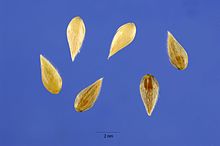| Phalaris aquatica | |
|---|---|
 | |
| Scientific classification | |
| Kingdom: | Plantae |
| Clade: | Tracheophytes |
| Clade: | Angiosperms |
| Clade: | Monocots |
| Clade: | Commelinids |
| Order: | Poales |
| Family: | Poaceae |
| Subfamily: | Pooideae |
| Genus: | Phalaris |
| Species: | P. aquatica |
| Binomial name | |
| Phalaris aquatica L.[1] | |
| Synonyms | |
| Phalaris tuberosa | |
Phalaris aquatica, known by the common names bulbous canary-grass[2] and Harding grass, is a species of grass in the genus Phalaris of the family Poaceae.
Description
It is an erect, waist-high, stout perennial bunch grass with grayish to bluish green leaves. Flowering heads are dense, spike-like, and usually two to five inches long. It is slow to develop from seed, but can form large bunches after several years.[3]
Phalaris arundinacea (reed canary grass) differs from Harding grass in having more distinct rhizomes and an inflorescence that is compact at first but later becomes more open as the branches spread.
Hybrids of Harding grass and reed canary grass have been produced. Varieties include 'AQ1', 'Uneta', and 'Australis'.
Geography
Phalaris aquatica originated from Southern Europe and the Caucasus. It is now naturalized in South Africa, Australia, New Zealand and the USA.[4]
Chemical Constituent
Leaves and seedlings contain DMT, 5-MeO-DMT, Bufotenin and related compounds.[5][6]Also contains gramine [7]
Forage
Phalaris aquatica is a pasture species grazed by ruminants. The grass can also be cut, providing good quality fodder for grazing livestock for 8 to 12 months a year.[4]
Toxicity
Some Phalaris species contain gramine, which can cause brain damage, other organ damage, central nervous system damage and death in sheep[7] although Phalaris aquatica is said to be non-toxic.[8]
A raw, dried plant Phalaris aquatica contains approximately 0.1% DMT, 0.022% 5-MeO-DMT, and 0.005% bufotenin.[6] A particular strain of P. aquatica from Italy, labeled 'AQ-1', was reported to contain in excess of 1.0% alkaloid concentration.[9]
In Victoria, Australia, it is reported that kangaroos grazing on Phalaris aquatica may develop a condition known familiarly as 'Phalaris staggers', where coordination and mobility are affected.[10]
Invasive species
Harding grass is an invasive species in grassland, oak woodland, chaparral, and riparian habitats. Native grasses and grassland habitat in California are affected.
References
- ^ "Phalaris aquatica". Germplasm Resources Information Network (GRIN). Agricultural Research Service (ARS), United States Department of Agriculture (USDA). Retrieved 2008-04-02.
- ^ "BSBI List 2007". Botanical Society of Britain and Ireland. Archived from the original (xls) on 2014-10-23. Retrieved 2014-10-17.
- ^ ucce.ucdavis.edu
- ^ a b Heuzé V., Tran G., Boudon A., Lebas F., 2017. Bulbous canary grass (Phalaris aquatica). Feedipedia, a programme by INRA, CIRAD, AFZ and FAO. https://www.feedipedia.org/node/391
- ^ Tryptamine Carriers FAQ
- ^ a b Phalaris / DMT FAQ
- ^ a b Cheeke, Peter R. (31 August 1989). Toxicants of Plant Origin - Google Book Search. ISBN 9780849369902. Retrieved 2008-04-20.
- ^ http://www.regional.org.au/au/asa/1996/contributed/450oram.htm
- ^ Phalaris: Some of the many strains of interest.
- ^ http://www.abc.net.au/news/2018-06-21/grass-to-blame-for-staggering-kangaroos/9886884
